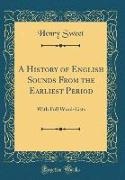Read more
Excerpt from A History of English Sounds From the Earliest Period: With Full Word-Lists
IN studying the phonetic development Of a language two methods are open to us, the historical and the comparative; that is to say, we may either trace the sounds Of one and the same language through its successive stages, or else compare the divergent forms in a group of languages which have a common origin.
Each method has its advantages. In the historical method the sequence of the phenomena is self-evident; when we compare two forms of the same sound in several co-existing languages, it is Often doubtful, which is the Older. The peculiar advantage Of the comparative method is that it can be applied to living languages, where nothing but careful Observation of facts is required, while in the case of dead languages the phonetic material is Often defective, and is always preserved in an imperfect form by means Of graphic symbols, whose correct interpretation is an indispensable pre liminary to further investigation. In short, we may say that the comparative method is based, or may be based, on facts, the historical on theoretical deductions.
About the Publisher
Forgotten Books publishes hundreds of thousands of rare and classic books. Find more at www.forgottenbooks.com
This book is a reproduction of an important historical work. Forgotten Books uses state-of-the-art technology to digitally reconstruct the work, preserving the original format whilst repairing imperfections present in the aged copy. In rare cases, an imperfection in the original, such as a blemish or missing page, may be replicated in our edition. We do, however, repair the vast majority of imperfections successfully; any imperfections that remain are intentionally left to preserve the state of such historical works.

